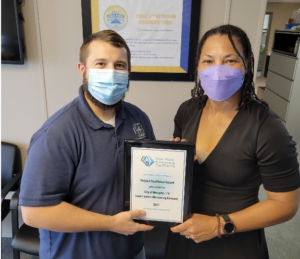Environmental Engineering
Environmental Engineering is responsible for the operation and maintenance of two large wastewater treatment facilities that treat over 60 billion gallons of wastewater each year and dispose of more than 215 million pounds of bio-solids annually in accordance with stringent State and Federal water quality regulations. They are also responsible for preventive maintenance and emergency repair of more than 3,000 miles of sewers and operation of approximately 100 sewer lift stations and 7 major flood control pumping stations.
Select a Subdivision for More Information
Wastewater Treatment
During the first 150 years of the City of Memphis’s existence, all the wastewater generated by its citizens and businesses was dumped untreated into the rivers, creeks, and ditches in and around the community. This was one of the primary causes of the famous yellow fever epidemic in 1878. It was not until 1975 that the first attempt was made to treat the wastewater generated by the southern half of the City of the T.E. Maxson Wastewater Treatment Facility. Two years later in August of 1977, the M.C Stiles Wastewater Treatment Facility was completed and began serving the northern half of the City.
M.C. STILES WASTEWATER TREATMENT FACILITY
The Stiles Facility now serves over 300,000 people. The people, businesses, and industries in the service area generate approximately 100 million gallons of wastewater each day (MGD). The wastewater is conveyed to the facility, mostly by gravity, through hundreds of miles of lateral servers and interceptor sewers. Each sewer line converges with a larger line until, at last, one large interceptor sewer conveys the total sewage flow into the Stiles Facility. The interceptor sewer is about sixty feet below ground level when it enters the facility.
T.E MAXSON WASTEWATER TREATMENT FACILITY
This was one of the primary causes of the famous yellow fever epidemic in 1878. It was not until 1975 that the first attempt was made to treat the wastewater generated by the southern half of the City of the T.E.Maxson Wastewater Treatment Facility. Two years later in August of 1977, the M.C Stiles Wastewater Treatment Facility was completed and began serving the northern half of the City.
BIOSOLIDS HANDLING
Covered aerobic lagoons further treat the excess biological solids generated in the secondary treatment process. In the process, over about a year, the biological solids continue to digest producing biogas, which is made up of carbon dioxide and methane. The remaining well-digested solids are dewatered using mechanical presses and placed on a surface disposal site for further drying. The goal is to produce a stabilized product suitable for reuse. The biogas is sold to a local industry and/or flared as necessary.
PRELIMINARY TREATMENT
A vast network of gravity sewers collects the wastewater which is conveyed to the Stiles or Maxson Facility. Many types of debris find their way into the sewer system along with the wastewater. Much of this debris could cause damage to the pumps and piping in the treatment facility. The wastewater passes through bar screens which remove the larger debris such as rags, sticks, cans, and even tires. Smaller inorganic debris, such as sand, gravel, is removed in this grit system. The lighter organic solids remain suspended in the wastewater and flow into the secondary treatment system.
Maintenance and Inspections
City of Memphis’ Maintenance and Inspection crews consist of over 150 employees who maintain and operate over 3,000 miles of sanitary sewer lines constructed of various materials including concrete, vitrified clay, PVC, and ductile iron. During the late 1800’s the City of Memphis experienced a yellow fever plague, and engineers recognized the need to separate the sanitary system from the storm water system. This decision resulted in the City of Memphis becoming one of the first cities in the country to introduce this concept of a separate piping system for sewer and storm water. Responsibilities required to maintain this system include closed circuit television (CCTV) inspection, sewer line cleaning, preventative maintenance and emergency repairs of sanitary sewer infrastructure. In addition, the Fats Oils and Grease (FOG) program adds a public education initiative and is responsible for response, investigation, and enforcement of all food establishments discharging into a sanitary sewer system.
Flood Control
The City of Memphis Public Works Division maintains a Flood Control Emergency Section to operate and maintain facilities as necessary to protect the City of Memphis from damage caused by floods. Memphis maintains a storm sewer system completely separate from the sanitary sewage system. The flood control system includes seven major flood pumping stations in conjunction with twenty miles of earth levees, two miles of concrete floodwalls, thirty floodgates, and six hundred and forty-three acres of reservoirs. Much of the construction of the flood protection system was completed from 1940 through 1964 as a result of the major flooding that occurred in 1937.
LEVEES, PUMP STATIONS, AND FLOODWALLS
During rainfall events, the stormwater runoff flows to the Mississippi via the Wolf River, the Wolf River Lagoon, and Nonconnah Creek. However, when the rivers have a high water level the levees may be closed so runoff must be pumped over the height of the levee system to be discharged directly to the receiving stream. During flood events, City staff are on call 24 hours a day 7 days a week until flood waters recede.
Lift Stations
City of Memphis’ crews maintains approximately 100 sanitary sewer lift stations necessary to pump sanitary sewer water to areas that cannot be serviced by gravity flow. These stations range from serving a small number of households to pumping millions of gallons of wastewater every day. City staff is responsible for the maintenance and inspection of these stations. A networked communication system installed for each lift station notifies staff when pumps are in need of maintenance or other conditions exist. City staff is on call 24 hours a day 365 days a year to respond to alarms and perform emergency maintenance when necessary.
Industrial Monitoring
The Industrial Monitoring and Pretreatment Program regulates Industrial facilities that discharge process wastewater to the City of Memphis wastewater collection and transmission system (WCTS). Based upon the number of discharges, the Program is currently the largest in Tennessee and EPA Region 4, and also ranks in the top 20 largest Programs in the country. The objective of the Program is to ensure the protection of human health and the environment through the application of engineering and scientific principles focused on industrial discharges to the WCTS. Industrial discharges must not physically damage the WCTS or impede the wastewater treatment process. Industrial facilities that meet the criteria of a Significant Industrial User (SIU) must be permitted by the Program before discharging to the WCTS.
The Project Excellence Award
The City of Memphis was presented the Project Excellence Award for their Smart Sensor Monitoring Network at the KY/TN Water Professionals 2021 Conference in Chattanooga, TN on 8/17/2021.
Helpful Documents
IWDP Permit Application
COM pH Excursion Policy
Ord. 5793_SUO
IMPP Newsletter
Sewer Availability Request

SARP10™
SARP10™ – or Sewer Assessment and Rehabilitation Program – is an initiative that will bring improvements to the sanitary sewer system in the City of Memphis over the next 10 years. The SARP10 team will implement the program through a series of condition assessment and construction rehabilitation projects over the life of the program. The first portion of the project consisted of two Pilot Areas in which condition and assessment work began in November 2013, followed by Phase 1 work which was completed in February 2015. Phase 2 work started January 2015 and was completed in early July 2015. Phase 3 work followed starting late September 2015 and was completed in June 2016. Phase 4 is currently in progress, starting work in April 2016 and is scheduled to be completed in February 2017. The program will move from neighborhood to neighborhood until the entire sanitary sewer system within the City of Memphis has been assessed.
The City of Memphis (City), like a lot of cities across the nation, has an aging wastewater collection and transmission system (WCTS). Although the City has historically maintained the WCTS, in response to the regulatory environment across the country the City negotiated an agreement (consent decree) to conduct more extensive assessment and rehabilitation measures. The consent decree (CD) was negotiated with the U. S. Environmental Protection Agency, the Tennessee Department of Environment and Conservation, the Department of Justice and the Tennessee Clean Waters Network and became effective on September 20, 2012. The CD establishes protocols and projects for the enhanced assessment and rehabilitation program. The purpose of the CD program is to minimize the number of sanitary sewer overflows (SSOs). Information available on the website includes the following:
- Interactive map to show when SARP10 crews will be conducting assessment work in your neighborhood.
- Email contact and hotline number for additional information.
- Copies of the CD and associated reports and programs.
- Information on upcoming, and past, community meetings.
- The type of assessment and rehabilitation work conducted by SARP10.
- List of current and former assessment and rehabilitation projects.
- Safety protocols for working in neighborhoods.
- Frequently asked questions.
- Message from the Mayor regarding the SARP10 program.
- News article related to the SARP10 program.
FOG
The City of Memphis Fats Oils and Grease (FOG) Program currently monitors over 3000 Food Establishments through inspection and regulation. This FOG program is a proactive approach to protect the sanitary sewer system from the negative effects caused by the introduction of FOG. Grease blockages are a primary cause of Sanitary Sewer Overflows (SSO’s). In an effort to help reduce SSO’s the FOG program conducts inspections to ensure food establishments are properly servicing and maintaining their grease removal equipment.
For more information:
901-636-4337
Effective January 1, 2025, Food Establishment Grease Trap Application for grease traps will be processed through Develop 901 Citizen Portal.
Use the “Engineering Permits” section of the Develop 901 Citizen Portal to request Food Establishment Grease Trap Application
Access Portal HERE
Looking For
Something Else?

Call 311 for a service request
Call 211 for community services
901-636-6500



